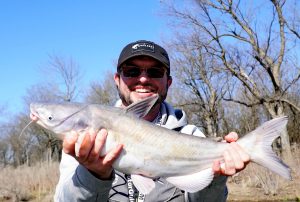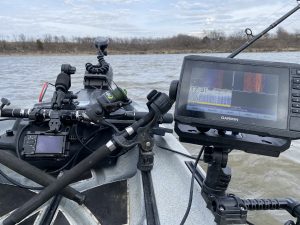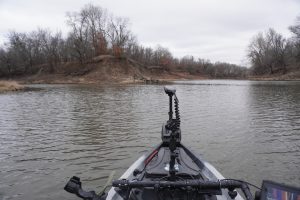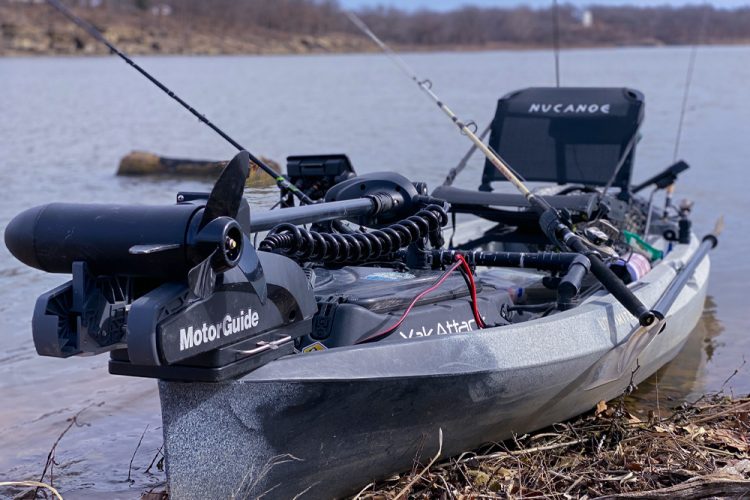The author’s kayak catfishing setup is a Nucanoe Unlimited
rigged with a trolling motor, depthfinder and safety flag.
Kayak Catfishing: Big Water vs. Skinny Water
Story and photos by Wes Littlefield
Location and technique strategies for kayak catfishing in reservoirs versus rivers.
Catfishing runs through my veins. I swear my dad’s grandpa was part catfish. He knew where to go and how to catch them no matter the conditions. I also own pictures of my mom’s dad hauling in giant flatheads and blue cats out of our local lake.

So, it was only natural for me to pick up catfishing, just not from a tiny plastic boat.
Growing up, I was primarily a bank angler, which severely limited my options. But when I began fishing from a kayak, it opened up a new world of possibilities.
I could now reach places that other boats couldn’t, plus the ones they could, which has led to some incredible catches and, at the very least, many fun adventures.
However, I’ve learned that it isn’t wise to approach a river with the same mindset and techniques as you do a reservoir when catfishing.
River Catfishing In a ‘Yak
I always feel at home on the river, regardless of where the river is located. And living in Oklahoma, catfish call all of our rivers home.

I’ve caught small channel cats while bass fishing, trout fishing and catfishing. I must say catching channel catfish on my ultralight trout gear is a blast, but I prefer to target blues and flatheads in the river using more robust equipment.
Speaking of gear, my setup doesn’t change much from the river to the lake. I use my Nucanoe Unlimited, though I wouldn’t mind using a smaller kayak in the river. If the water is murky, I like to use my depthfinder to locate the deepest holes. But I can also use my paddle to get an idea of the depth.
I fish a slip-sinker rig on 50-pound braid with a one- to two-foot 30-pound mono leader. Sometimes, I use a stronger leader if I know there’s a chance to run into giant cats. But a 30-pound leader is difficult to break when you get snagged, which happens often in the rivers. That’s because of where I like to fish when in the river.
The only time I’m not fishing a deep hole at the mouth of a creek is when there’s a brushpile or logjam nearby. Generally, I prefer the brushpile to be in deeper water, but I’ve caught fish out of brushpiles in one to two feet of water. There’s always a chance for a bite in a brushpile.
Unless I find a long, deep hole that I can slowly drift down, I tend to anchor in the river and allow the current to carry my bait’s scent downstream.
Reservoir Catfishing In a ‘Yak
Due to the increased volume of water, kayak catfishing in a lake is more complicated than on a river. One day you might catch them along a ledge on the main lake, and the next you might find them on a flat in the back of a cove.

This is why I like to hit high percentage areas such as bridges, creek and river channels, and wind-blown banks. Bridges are my favorite because no matter which direction the wind blows, a current will push the baitfish through. Bridges also condense the area where fish will likely be, so you’ll spend less time searching and more time fishing.
Catfish use creek and river channels as travel corridors, so fishing along these ledges tends to be good most of the time. Windblown banks are excellent because the wind pushes baitfish into the shallows, where it’s easy for the larger fish to feed. However, excessive wind can be dangerous for a large boat, and especially a kayak, so always use caution when kayak fishing on breezy days.
The nice thing about fishing in a reservoir or lake is you can drift or anchor your kayak. When the wind is relatively calm, it is a great time to drift fish to find a few hungry fish. However, anchoring is the best option on days that are a little windy or when the catfish won’t chase your baits.
When kayak fishing in a reservoir or lake, I always use a depth finder and a bright orange flag to remain as visible as possible so I’m less likely to get run over by a boat.
Kayak Catfishing Must-Haves
Whenever I’m kayak catfishing, I always have this gear with me:
- Life vest (always wear your life jacket while kayak fishing)
- Paddle
- Extra water and snacks
- Pliers
- Scissors/knife
- Heavy-duty rods and reels (at least two, but I’ve used as many as four at a time)
- Extra hooks, swivels and sinkers
- Bait: cut-bait, worms, stinkbait or live bait
Kayak Catfishing Nice-to-Haves
While the following gear isn’t mandatory, it will definitely come in handy multiple times:
- Anchor and rope
- Spot-Lock trolling motor
- Lithium trolling motor battery (50Ah-100Ah)
- Fish finder
- Lithium fish finder battery (25Ah-50Ah)
- Rod holders
- Kayak Kushion
- Waterproof boots
Last Cast
While the differences between catfishing in a river and catfishing in a reservoir might seem minimal, it’s important to remember that the details set apart the great anglers from the good anglers.
Subtle adjustments in location, bait and gear keep the great anglers catching fish while the good anglers wonder what will work.
(Wes Littlefield is obsessed with kayak fishing. He loves taking his daughter in his Nucanoe Unlimited to catch a few catfish for dinner or a fun day on the water. Few thrills match getting pulled around by a big ol’ cat on a kayak, but when he’s not kayak fishing, he’s hunting, hiking or playing disc golf with his family.)



